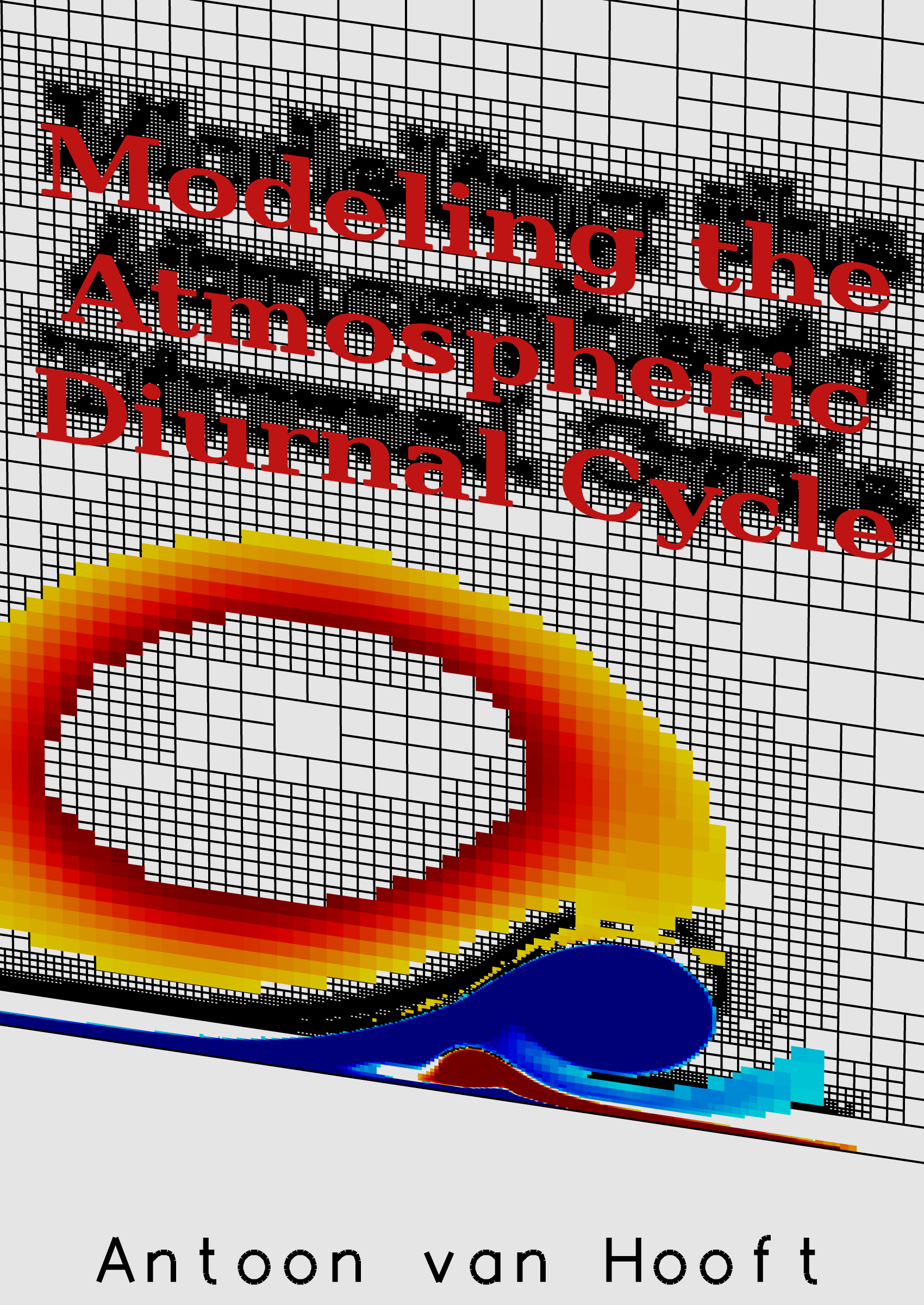sandbox/Antoonvh/front_page.c
The Frontpage for a Thesis.
This page is usefull for those who wish to obtain a thesis cover with the title ‘Modeling the diurnal cycle’ and go by the name ‘Antoon van Hooft’.
What?
The cover visualizes vorticity dynamics which are computed with the Navier-Stokes solver. The title’s letters are represented on a tree grid. We follow this test page. Finally, Basilisk view is used to visualize the corresponding tree data.
#include "navier-stokes/centered.h"
#include "distance.h"
#include "fractions.h"
#include "view.h"The setup follows the setup of the vortex-wall collision, which is governed by a Reynolds number Re,
double Re = 4000.;
u.t[bottom] = dirichlet (0.);
int main() {
L0 = 15.;
X0 = -L0/2;
const face vector muc[] = {1./Re, 1./Re};
mu = muc;
run();
}The flow is initialized with a Lamb-Chaplygin dipolar vortex.
double yo = 5, xo = 0.1; //Dipole centre coordinate
#define RAD (pow(sq(x - xo) + sq(y - yo), 0.5)) //r(x,y)
#define ST ((xo - x)/RAD) //Sinus of the azimuth angle
event init (t = 0) {
double k = 3.83170597;
scalar psi[];
refine (RAD < 2.0 && level <= 9);
refine (RAD < 1.0 && level <= 10);
foreach()
psi[] = ((RAD > 1)*((1/RAD))*ST +
(RAD <= 1)*(-2*j1(k*RAD)*ST/(k*j0(k)) + RAD*ST));
boundary ({psi});
foreach() {
u.x[] = -((psi[0, 1] - psi[0, -1])/(2*Delta));
u.y[] = (psi[1, 0] - psi[-1, 0])/(2*Delta);
}
boundary({u.x, u.y});
}We use an adaptive grid.
event adapt (i++)
adapt_wavelet({u.x, u.y}, (double[]){0.025, 0.025}, 11); // 11Generate the image
At t = 6 an event is called that outputs the image.
event output_image (t = 6) {
scalar d[], omega[];First we load and place the title letters that are stored in the
.gnu format and are generated with Inkscape and
Gnuplot.
double ttx = .9, tty = 1.2, ttw = 1.5;
coord * p;
coord min, max;
p = input_xy (fopen ("front_page.title.gnu", "r"));
bounding_box (p, &min, &max);
int j = 0;
double w = max.x - min.x;
while (p[j].x > 0.1 && p[j].x < 1E6) { //Reshape
p[j].x = (p[j].x - min.x)*(ttw/w) + ttx;
p[j].y = (p[j].y - min.y)*(ttw/w) + tty;
j++;
}
distance (d, p);
while (adapt_wavelet ({d, u.x, u.y}, (double[]){1e-3, 0.02, 0.02}, 13).nf);
vertex scalar phi[];
scalar f[];
foreach_vertex()
phi[] = (d[] + d[-1] + d[0,-1] + d[-1,-1])/4.;
face vector s[];
fractions (phi, f, s);Next, The vorticity field is computed and made transparant in some locations.
vorticity (u, omega);
foreach()
if (fabs(omega[]) < 2 || (y > 0.2 && omega[] > 7))
omega[] = nodata;The last step is to output a high resolution image with
bview commands.
view (fov = 2.87579, phi = 0.61, theta = 0.25,
tx = -0.106311, ty = -0.035, bg = {0.9,0.9,0.9},
width = 1700, height = 2400, samples = 4); //Set the camera,
draw_vof ("f", "s", filled = 1, fc = {0.9, 0.1, 0.1}); //print the title,
squares ("omega", min = -7, max = 7); //plot vorticity field,
translate (z = -0.1) //move to the back ground
cells (lw = 4); //plot the cells,
draw_string (" Antoon van Hooft", size = 20, lw = 10);//add the author's name,
box (notics = true, lw = 4); //And draw a boundary line.
#if 0 //Flip switch for `raw` output
save ("front_page.ppm"); //Save the image
#else
save ("front_page.png"); //Possibly compressed
#endif
}The result
Here is the cover:

